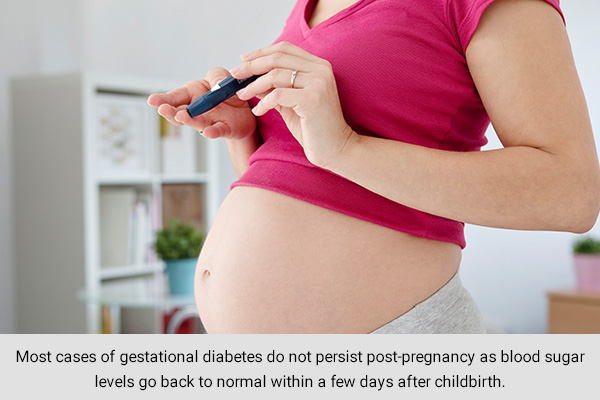In this article:
Some expecting mothers, without any history of diabetes prior to conception, encounter an unanticipated surge in their sugar levels during pregnancy because their bodies start resisting insulin. In most cases, the elevated sugar levels tend to resolve as soon as the baby is born. This form of temporary diabetes is known as gestational diabetes mellitus (GDM) and typically develops between the 24th and 28th weeks of pregnancy.

Along the same lines as other types of diabetes, gestational diabetes also affects how your cells process sugar or body glucose. Up to 9.2% of pregnant women suffered from this problem in 2010, according to a 2014 analysis by the Centers for Disease Control and Prevention. (1)
Given its widespread prevalence, it is recommended that all pregnant women get tested for gestational diabetes at the beginning of the third trimester, or around approximately the 28th week of pregnancy.
Causes of Gestational Diabetes Mellitus
- The exact cause of gestational diabetes mellitus is unknown, but the hormonal changes during pregnancy play a key role. During pregnancy, the body produces larger amounts of some hormones like human placental lactogen and estrogen, which can increase the body’s resistance to insulin, the hormone responsible for regulating blood sugar. Because insulin serves the function of transferring glucose from the blood into the cells to be later utilized for energy, an increased resistance to insulin amounts to glucose buildup in the bloodstream. This high level of blood glucose can have damaging effects on the baby’s health as well.
- Gestational diabetes typically occurs in late pregnancy after the baby’s body has been formed. It does not typically cause the kinds of birth defects that can occur in babies of mothers who had diabetes before pregnancy.
- Risk factors for developing gestational diabetes mellitus include being older than 25, pre-existing high blood pressure, a family history of diabetes or personal history of pre-diabetes, and being overweight or obese before pregnancy. (2)(3)
- Gestational diabetes is linked to polycystic ovary syndrome (PCOS), which has similar effects on the body’s hormones and resistance to insulin. (4)
- Women who have previously given birth to a baby weighing more than 9 pounds or had an unexplained miscarriage or stillbirth are also at an increased risk for gestational diabetes mellitus. (5)
Symptoms Indicative of Gestational Diabetes

Gestational diabetes typically doesn’t exhibit any symptoms and is usually picked up during the routine blood sugar tests that are administered as part of every gynecologist-recommended prenatal care. Occasionally, mild symptoms appear such as:
- Fatigue
- Blurred vision
- Excessive thirst
- Excessive need to urinate. (4)
Prevention Against Gestational Diabetes Mellitus
- Instead of eating three large meals, break your pattern by eating smaller portions of food at regular intervals throughout the day.
- Frame a diet plan that includes a variety of foods, such that you can meet your health goals without compromising on either nutrition or taste.
- Eat lots of green leafy vegetables.
- Eat low-glycemic-index fruits, such as apples, guava, oranges, and watermelon.
- Limit the amount of fat you eat, particularly saturated fat. Use healthy fats for cooking, like olive oil and polyunsaturated oils, and eat more foods like avocados and unsalted nuts, which contain plenty of such fats.
- Eat at least two small servings of protein a day to support the growth of your baby.
- Include two to three servings of low-fat, calcium-rich foods in your diet daily.
- The best drink for your body is water. Plain mineral water with fresh lemon is a quick and easy way to keep your body hydrated.
- Closely monitor the movement of your baby. If you do not feel any movement or have noticed a significant change in your baby’s movement for a couple of hours, call your healthcare provider immediately.
- Since being overweight before becoming pregnant increases your risk of developing gestational diabetes mellitus, it is well advised to shed the extra pounds before you plan your pregnancy.
Complications With Gestational Diabetes

- Developing gestational diabetes during pregnancy is not indicative that the condition will persist even after delivery. In most cases, blood sugar levels will return to normal within a few days post-delivery. It does, however, make you predisposed to developing type 2 diabetes later in life. (4) For this reason, it is important to get screened for diabetes later than 12 weeks after the birth and then again every 3 years after that.
- It is important to remember that untreated or poorly controlled gestational diabetes can lead to macrosomia or a large baby with high body fat. While the blood sugar travels past the placenta to reach the baby, the mother’s countering insulin does not. When the mother has high blood glucose levels, the baby’s pancreas creates extra insulin to regulate its body sugar levels. The baby’s body then stores this extra sugar as fat, making it grow to 9 pounds or more.
- Larger babies, in turn, are difficult to deliver as they pose the risk of getting wedged in the birth canal and thus necessitating the need for a C-section or induced labor. Babies born to mothers with gestational diabetes are also at a higher risk for obesity and type 2 diabetes further down the line.
- Furthermore, they are susceptible to developing hypoglycemia or very low blood glucose levels at birth as well as breathing problems.
- Gestational diabetes can be controlled and treated with lifestyle and dietary changes. At times, it is necessary to get treatment with medications to keep the body’s blood glucose levels well controlled, ensuring a healthy mom, baby, and delivery.
Final Word
Once you are diagnosed with gestational diabetes, you will have to work closely with your doctor who will monitor your sugar levels and weight gain and prescribe the necessary treatment. This is also true for mothers who have experienced this problem in their previous pregnancy.
 Continue ReadingHow to Manage Gestational Diabetes at Home
Continue ReadingHow to Manage Gestational Diabetes at Home
- Was this article helpful?
- YES, THANKS!NOT REALLY


